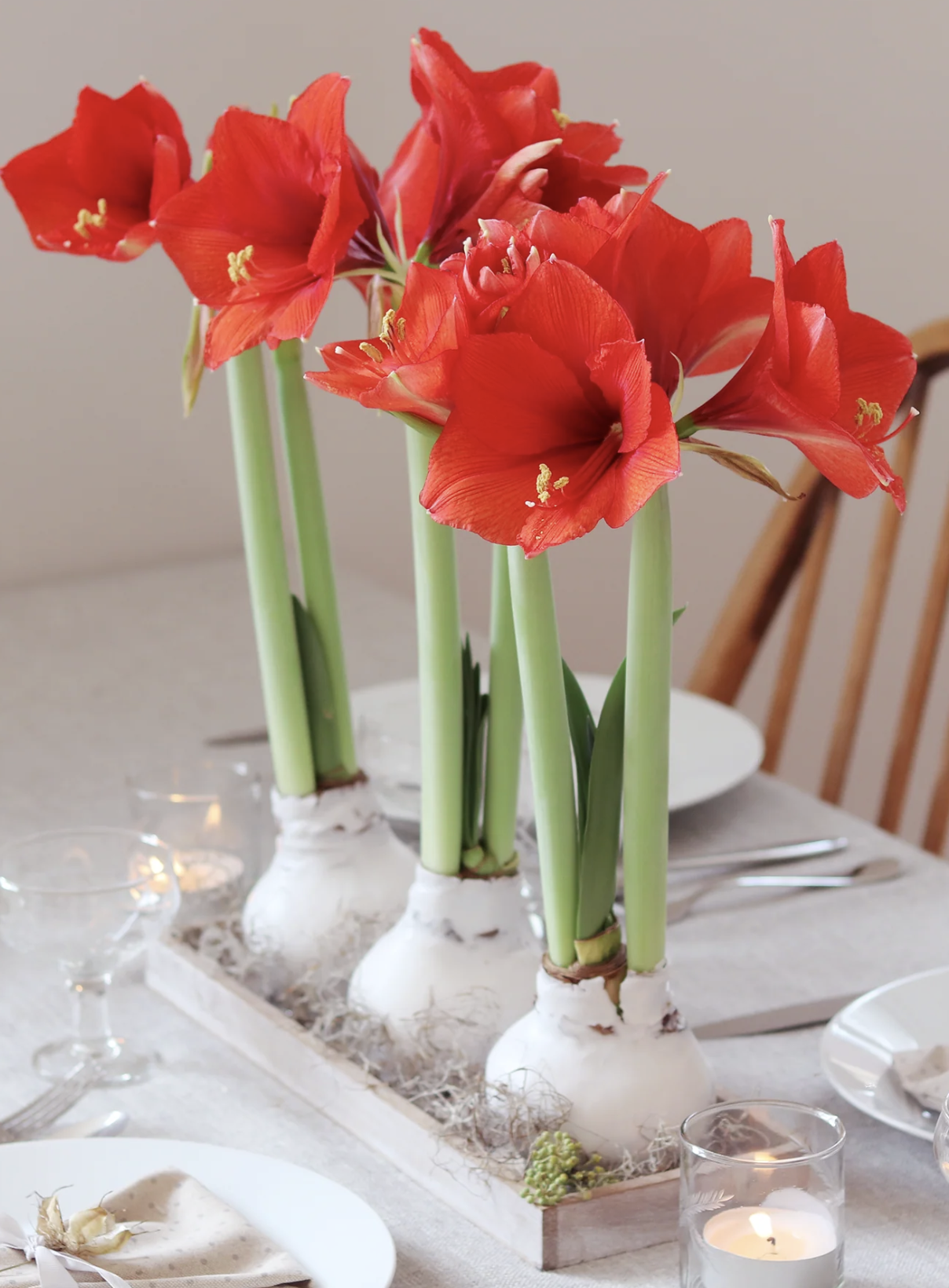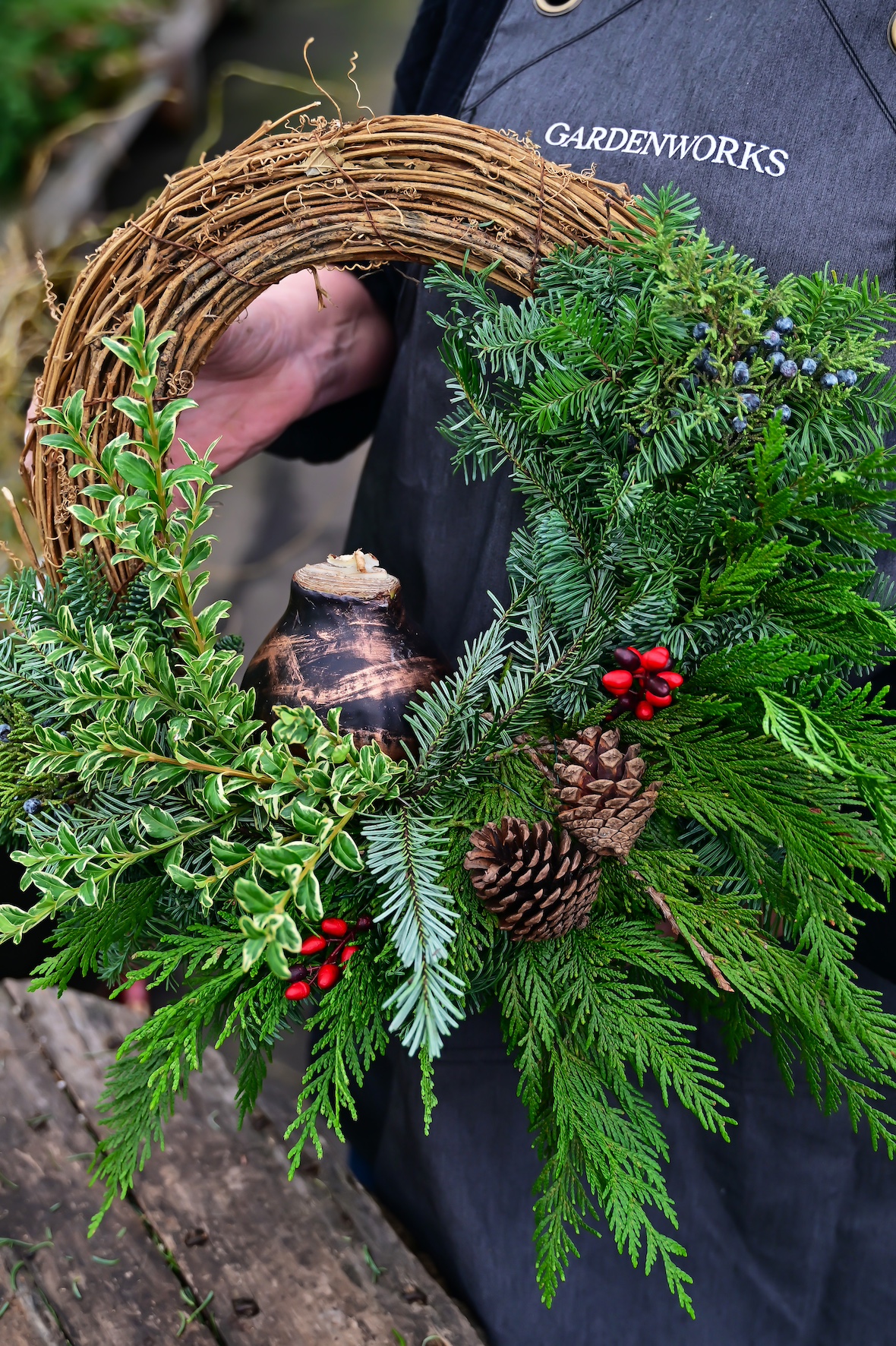Waxed Amaryllis Bulbs Are This Year's Viral Christmas Flower — Here's Everything You Need to Know, Including How to Make a Wreath
Watch this beauty bloom into a beautiful festive floral display — even in a wreath and here's how you can make your own

If you're wondering, what all the fuss is about waxed amaryllis bulbs, try one and discover for yourself this fuss-free way to create a sensational festive floral display.
Waxed amaryllis bulbs required no water or soil to be able to flower, so you don't need all the amaryllis growing and care tips you might usually read up on. They're also available with different color wax coatings, from red, white, and green to gold, silver, and more. So, it's easy to use them in a table centerpiece or mantelpiece decoration and watch them bloom over the festive season. Some florists have even included them in festive wreaths that burst with beautiful flowers — you can see one below.
You can discover more about waxed amaryllis bulbs and what you can do with them, below.
What Are Waxed Amaryllis Bulbs?

Amaryllis store water and nutrients in their bulbs. This enables them to be able to go dormant and survive tough environmental conditions, if they need to, before entering the next growth cycle.
"By applying layers of wax to the bulb, it’s using all the moisture and nutrients it has stored up, rather than augmenting by rooting and growing out," says Justin Hancock, horticulturalist, Costa Farms. "This makes it incredibly easy to enjoy. There's no need to do anything to it—no potting, no watering, etc."
How long do waxed Amaryllis bulbs last?

Waxed amaryllis bulbs will flower within three to six weeks and the blooms will last for two to three weeks, according to Justin. It's unusual for a waxed amaryllis bulb to re-flower but not impossible.
"If you want the easy-care, no-fuss experience, your amaryllis bulb will last around six to eight weeks," says Justin. "After its flowers have all faded, the bulb begins to become exhausted. It can be tricky to get a waxed Amaryllis to re-bloom, if you wait to take the wax off after it’s done. A percentage of the bulb won’t continue to grow.
Paris Lalicata, plant expert, The Sill, tells us: "Once the bulb has bloomed, it usually creates two stalks that produce up to four flowers each. After blooming, unlike un-waxed Amaryllis, the bulb cannot generally be reused for future growth. Waxed amaryllis is really a one-time ornamental option, which a lot of plant parents prefer."
What to do with amaryllis after it blooms? Peel off the wax and compost it.
How to decorate with waxed Amaryllis bulbs?

"The fact that you can buy it, set it where you want, and not have to do anything else with it makes waxed amaryllis bulbs super appealing with a lot of people," says Justin. "It’s an easy way to enjoy the beauty of your holiday décor and Christmas flowers without having to worry about whether you’re giving it enough water.
"The aesthetics also come into play with new generations too," continues Justin. "There’s something so visually impactful about this bulb covered in an eye-catching colored wax topped by clusters of bright red flowers. It's uniquely experiential too–you watch them go through a process — seeing the flower bud slowly push up and out of the bulb, the buds swell and start to break color, and then fully open.
Justin adds: "It changes practically every day, making it fascinating to enjoy —especially for children, who are often mesmerized by the growing process. It really is amazing to see it grow over the course of a few short weeks."
"Waxed amaryllis bulbs are a low-maintenance way to create a stunning centerpiece or accent, complementing holiday decor with their vibrant, red trumpet-shaped blooms," says Paris. "They require no soil or watering, and the wax coating is available in various colors and finishes. They also make great gifts for plant parents of all levels."
How to Make an Amaryllis Wreath Using Waxed Bulbs

If you want to decorate for Christmas with fresh foliage and flowers, Amaryllis is a beautiful choice. However, waxed Amaryllis bulbs take 3-6 weeks to flower. So if you want to make a wreath now, use a waxed bulb that is already sprouting. Otherwise, you will have to wait until the new year to see it flower.
What You'll Need
Before you start, gather the following items, as you will need these to assemble your Amaryllis wreath:
TOOLS AND ITEMS
• Waxed amaryllis bulb — We love this Red Base Waxed Amaryllis Flower Bulb from Amazon.
• Grapevine wreath base. Like these Juvale Set of 3 Grapevine Wreath Forms from Target.
• Fresh evergreen clippings (cedar, fir, pine, etc.)
• Accent greenery (e.g., boxwood or variegated foliage)
• Pinecones
• Decorative berries — These 12Pcs Artificial Red Berries Stems from Amazon should do the job.
• Floral wire
• Wire cutters or pruners. We like this Haus & Garten ClassicPRO 8.5" Professional Premium Titanium Bypass Pruning Shears from Amazon.
• Twine or ribbon (optional for hanging)
A Step-By-Step Guide
GardenWorksresident floral expert, Eveline Young talks us through how to make an Amaryllis wreath with a step-by-step guide. The wreath can be hung inside over a mantle, and the bulb will eventually flower.
Step 1: Eveline says you should "Begin with a grapevine wreath as your foundation. Its natural, rustic look works perfectly with fresh greens and gives the wreath a sturdy structure."
Step 2: "Using pruners, cut evergreen clippings into smaller, manageable pieces. Start with the larger evergreen pieces, such as cedar or fir, as the base layer for fullness," explains Eveline. "Layer the greenery onto the wreath base, tucking stems into the grapevine and securing them with floral wire as needed."
Step 3: "You can add texture and dimension by incorporating smaller pieces like boxwood or variegated greens. Work in one direction around the wreath to create a cohesive look," she continues.
Step 4: "The waxed amaryllis bulb will serve as the focal point of your wreath," says Eveline. "Place the bulb at the bottom or slightly off-center of the wreath for visual interest. Ensure you give the bulb space to grow as it blooms. The bulb can be secured in place using floral wire. Twist the wire into a circle for the bulb to sit in and attach it to the base with another piece of floral wire.
Step 5: You can "Accent the greenery with natural elements like pinecones and bright red berries for a festive touch. Once you’re happy with the arrangement, fluff up the greenery and ensure everything is secure. Then add a ribbon or bow for a polished finish.
The expert says you can "Keep your wreath looking fresh by misting the greenery lightly with water every few days."
Be The First To Know
The Livingetc newsletters are your inside source for what’s shaping interiors now - and what’s next. Discover trend forecasts, smart style ideas, and curated shopping inspiration that brings design to life. Subscribe today and stay ahead of the curve.
Jacky Parker is a London-based freelance journalist and content creator, specialising in interiors, travel and food. From buying guides and real home case studies to shopping and news pages, she produces a wide range of features for national magazines and SEO content for websites
A long-time contributor to Livingetc, as a member of the team, she regularly reports on the latest trends, speaking to experts and discovering the latest tips. Jacky has also written for other publications such as Homes and Gardens, Ideal Home, Red, Grand Designs, Sunday Times Style and AD, Country Homes and Interiors and ELLE Decoration.
-
 The 'New British' Style? This Victorian London Home Embraces Its Owners' Global Background
The 'New British' Style? This Victorian London Home Embraces Its Owners' Global BackgroundWarm timber details, confident color pops, and an uninterrupted connection to the garden are the hallmarks of this relaxed yet design-forward family home
By Emma J Page
-
 Muji Living Room Ideas — 5 Ways to Harness The Calming Qualities of This Japanese Design Style
Muji Living Room Ideas — 5 Ways to Harness The Calming Qualities of This Japanese Design StyleInspired by Japanese "zen" principles, Muji living rooms are all about cultivating a calming, tranquil space that nourishes the soul
By Lilith Hudson
-
 These Are the Dos and Don'ts of Bamboo Plant Placement — Follow This to Avoid Bad Feng Shui
These Are the Dos and Don'ts of Bamboo Plant Placement — Follow This to Avoid Bad Feng ShuiBy following the experts' guidance on where to place this houseplant you can usher luck, wealth, and prosperity into your home
By Lilith Hudson
-
 Is It Okay to Have a Mirror Facing a Door in Feng Shui? The Verdict Is In and It Just Might Surprise You
Is It Okay to Have a Mirror Facing a Door in Feng Shui? The Verdict Is In and It Just Might Surprise YouDecorating your home with mirrors calls for intention if you're dressing your space in accordance with Feng Shui. Here's what you should know.
By Amiya Baratan
-
 4 Things to Unpack as Soon as You Move House — For a Comfortable and Organized Fresh Start
4 Things to Unpack as Soon as You Move House — For a Comfortable and Organized Fresh StartIf you have a major move in the works and you're looking to prepare in advance, this is the starter kit you need to properly set up your new home.
By Amiya Baratan
-
 10 Decluttering Challenges to Have on Your Radar This Year — For a Tidier, More Mindful Home
10 Decluttering Challenges to Have on Your Radar This Year — For a Tidier, More Mindful HomeIf you're interested in transforming your home for the better, here are 10 decluttering challenges I recommend for a professionally tidy space.
By Amiya Baratan
-
 Biophilic Decluttering — What to Take Out of Your Home (and What to Put in) for a More Natural Home
Biophilic Decluttering — What to Take Out of Your Home (and What to Put in) for a More Natural HomeTry your hand at biophilic decluttering to ground your interiors, connect to the environment, and cure chronic clutter in one go. Here's how.
By Amiya Baratan
-
 The 10 Different Types of Kitchen Taps — And the Pros and Cons of Each One to Know Before You Pick
The 10 Different Types of Kitchen Taps — And the Pros and Cons of Each One to Know Before You PickFrom sleek pull-outs to vintage bridge taps, explore 10 kitchen tap styles that mix function, flair, and a splash of cool
By Linda Clayton
-
 How Much Does an Extension Cost in 2025? Renovation and Design Experts Break Down Your Budget
How Much Does an Extension Cost in 2025? Renovation and Design Experts Break Down Your BudgetExplore how much different types of extensions cost in 2025 to budget for your project accurately
By Amy Reeves
-
 9 Bathroom Storage Mistakes You're Probably Making That Make Using This Space Much Harder — And What to Do Instead
9 Bathroom Storage Mistakes You're Probably Making That Make Using This Space Much Harder — And What to Do InsteadDiscover which mistakes are to blame for your overcrowded and cluttered bathroom
By Seraphina Kyprios